WGEO AND WGEA --
GENERAL ELECTRIC'S TWIN SHORTWAVE STATIONS
By John F. Schneider W9FGH
|
|
WGEO AND WGEA -- By John F. Schneider W9FGH |
|
www.theradiohistorian.org Copyright 2021 - John F. Schneider & Associates, LLC (Click on photos to enlarge)
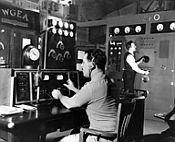 This view shows the same room just two years later - January, 1941. The 100 kW WGEO transmitter is at right; the older 50 kW transmitter at left broadcast for WGEA. (Author's Collection).
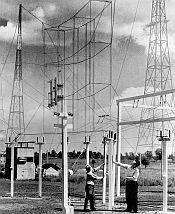 WGEO engineers are seen changing connections to the curtain antennas, September, 1940. Each vertical pole supports the transmission line for a different antenna, designed for a specific frequency and bearing. The line to the transmitter is attached by means of a long, insulated pole. (Author's Collection). 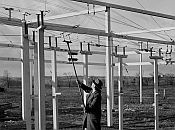 Another view of the antenna switching bay, November, 1941. The antennas are labeled “9550/9530 KC Europe/London”, “9550/9530 KC Latin America Buenos Aires”, “9550/9530 KC Latin America Rio”, and 15,330 Europe/London”. (Museum of Innovation and Science, Schenectady) 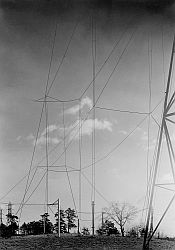 This view shows the 9,530 kHz curtain antenna of WGEO, targeting South America, November, 1941. (Museum of Innovation and Science, Schenectady) 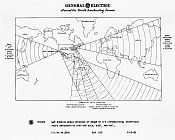 This map, dated November, 1939, shows the directional antenna beams of WGEO, WGEA and KGEI. (Museum of Innovation and Science, Schenectady) 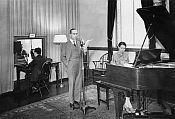 This was the W2XAF radio studio in May of 1939, broadcasting a program in Spanish. Announcer José Flores is seated at microphone; Prof. Vicente Tovar IS standing; and Aida Trennert is at the piano. (Museum of Innovation and Science, Schenectady) 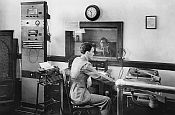 This is the opposite view through the control room window, looking back into the W2XAF studio. (Museum of Innovation and Science, Schenectady) 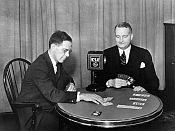 In May of 1935, W2XAF broadcast a unique inter-continental bridge game by radio. C. H. Lang, G.E. publicity manager (L) and John Lockton, G.E.’s assistant treasurer (R) were the north and west players in Schenectady. They played against a team of players located in Barranquilla, Colombia. The north and west bids were transmitted over W2XAF on 9,530 kHz; the east and south bids were returned over HJ1ABB on 6,440 kHz. The bridge hands were shuffled and dealt from VK2ME in Sydney, Australia. (Author's Collection). 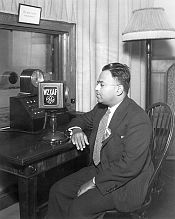 Here is N. Subramaniam of Bombay, India (today called Mumbai), transmits a program in the ancient Sanskrit language over W2XAF, July, 1935. (Author's Collection). 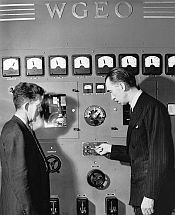 Robert E. Sherwood, director of the Office of War Information, dedicates WGEO’s new 100 kW transmitter in September, 1942. G.E. Engineer W. J. Purcell is at right. This unit replaced the first 100 kW transmitter that was shipped to KWID in San Francisco in December, 1941. (Author's Collection). 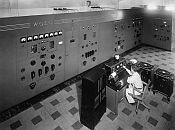 These were the updated wartime transmitters of WGEO (100 kW) and WGEA (50 kW) in June, 1943. (Museum of Innovation and Science, Schenectady) 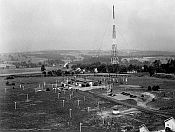 Here is a territorial view of the G.E. transmitting plant at South Schenectady, July 1944. The white posts carried the transmission lines to the different antennas – most of which are out of view. (Museum of Innovation and Science, Schenectady) 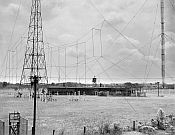 This photo shows the WGEO transmitting plant in 1957. This was late in its life, when it served as a transmitting station for the Voice of America. Operations ceased here in 1963. (Author's Collection). |
|
General Electric Explores the Shortwaves:
In
the early years of
radio communications, it was believed that only the long waves (below
500 kHz) were
suitable for long distance communications. RCA,
the Navy, and other communications interests had
invested vast sums
of money to construct elaborate radio facilities for trans-oceanic
communications on the long waves. General
Electric, manufacturer of the prestigious and
massive Alexanderson
alternator, was a major recipient of these investment dollars, as well
as being
a major investor in the newly-formed company, RCA. General
Electric was
already developing transmitter technology through the facilities of its
medium
wave station, WGY, which began broadcasting in February of 1922 from
Building
36 at G.E.’s massive Schenectady factory complex. WGY
had a dual purpose – to provide programs
as an incentive for the public to buy G.E./RCA radio receivers, and to
serve as
a laboratory for the development of radio transmission technology. In
October of 1923,
G.E. installed an experimental shortwave transmitter on Van Slyck
Island, adjacent
to the G.E. plant in Schenectady, NY. The
10 kW transmitter operated on 105 meters (2,850 kHz), using the
experimental call
sign 2XI which had been acquired for other purposes in 1916. Its purpose was to investigate shortwave
propagation and coverage. The transmitted
audio was of little importance, so 2XI simply rebroadcast the programs
of WGY. Occasionally, the station was used
to relay
certain WGY programs to KGO in Oakland, California, G.E.’s newest
medium wave
station. As
mentioned, G.E.’s
engineers and scientists were also exploring the development of medium
wave
transmitters at WGY, but this experimental work was increasingly
interfering
with the regular broadcast activities of the station.
It was finally decided that a more ample experimentation
space was needed, and that it should be located some distance from the
industrial
electrical interference at the plant. For
this new "Radio Laboratory", a 58-acre plot was
acquired
at the corner of Mariaville Road and Burdeck Street in South
Schenectady/Rotterdam
Township, three miles west of the plant.
Construction
of the
facility took place during 1924/25. A
main 60x100 ft. brick building was built, which housed the power
equipment,
high voltage rectifiers, motor generators, a water-cooling system, and
the
audio amplifier and modulator equipment. There
were four smaller wood-frame buildings located on
the property,
housing individual transmitters for different projects.
Cooling water was piped from the main
building to each of these structures, and the modulator power was fed
to the
transmitters on overhead lines. There
were three 300 ft. steel towers, arranged in a triangular
configuration, which
allowed for the construction of many different types of antennas. There was also a fourth steel tower, 150 ft.
tall, and three wooden masts which supported a 109-meter wire antenna. The WGY transmitter and antenna were moved to
this location and were fed by program lines from the Building 36 studio. The 2XI operation at Slike Island was shut
down. The
main building contained
two transmitters– 2XAG was on 790 kHz with 20 kW, and it served as the
WGY
transmitter; 2XAH operated with 50 kW on 192 kHz long wave. Shortwave operations took place in the wooden
buildings – one on 109 meters (2,752 kHz), and another pair on 20 and
40
meters. They were given the experimental
licenses 2XAF and 2XAG. The purpose of these stations was to test
shortwave
propagation, antennas, and transmitter designs. After
experimenting with a variety of frequencies, it was
determined
that 31 meters was the best choice for daytime propagation, while 19
meters worked
best at night. This decision
foreshadowed the creation of these international broadcasting bands
which are still
in use today. As
with 2XI, WGY’s
program audio was used as the shortwave test signal.
These programs soon developed a following
from regions outside WGY’s normal coverage, and letters started coming
in from
around the world - particularly Europe and South America. Responding to this demand, the stations began
broadcasting on a regular schedule - 2XAF starting on February 10,
1924, and
2XAD on August 28, 1925. In 1927, these
call signs became W2XAF and W2XAD. (The
“X” in these call signs indicated they were licensed as “Experimental
Relay
Broadcast Stations”.) By
1930, regular
operation saw W2XAD operating at 15,480 kHz with 18 kW from 10:00 AM to
3:00 PM
Eastern Time, targeting Europe. Then W2XAF
broadcast to Latin America on 9,530 kHz using 25 kW from 4:00 PM to
midnight. The transmitter powers were
later raised to 25 kW and 40 kW, respectively.
As
shortwave receivers
became more common among amateur operators and listeners, the programs
and
schedules of G.E.’s two shortwave stations became increasingly
significant. This was no longer just a
grand experiment; it
had developed a sizeable audience around the world. Increasingly,
separate programs were being
produced for these shortwave audiences, featuring American music,
Broadway
shows, the Metropolitan Opera, baseball games, and bridge games. Much of this was aimed at American
expatriates living overseas rather than foreign cultures.
Virtually all programs were in English.
W2XAD
and W2XAF served
as an important communications link for the three expeditions of
Admiral
Richard Byrd to Antarctica (1928-30; 1934; and 1939-40).
A special directional antenna aimed at
“Little America” in Antarctica, designed by Ernst Alexanderson,
amplified the
station’s signal ten times in the direction of Byrd’s camp. Entertainment programs were transmitted to
the expedition crew every other Sunday night at 11:00 PM, sponsored by
major
newspapers around the country and repeated by NBC on 51 domestic
stations. Then, after the domestic
stations cut away,
the G.E. stations broadcast the “Byrd Mailbag”, reading letters sent by
friends
and family to the expedition crew, and averaging 75-100 letters a
night. 1 In
1935, a new station
slogan was adopted: “The Voice of Electricity”. The
stations’ signature ID sound was the
recorded crash of
a 10-million-volt
arc created in the G.E. laboratories, and it was broadcast at the
beginning and
end of each transmission. In
many parts of the
world, the two G.E. stations were the strongest signals coming out of
the
United States. By 1937, the program hours had increased –290 hours per
month for
W2XAF, and 220 hours for W2XAD. As the
notoriety of the stations increased, international goodwill and foreign
language programs became an important part of the G.E. stations’
schedules. NBC produced a series of
special programs
aimed at South America, broadcast over the stations in 1938. A weekday news program, called the “American
News Tower”, was inaugurated in June, 1937, consisting entirely of news
of the
United States as reported by the Press Radio Bureau. It
was designed specifically to counter the
false or distorted news being broadcast by the fascist stations in
Europe. A weekly “American Travelogue”
program was
also created, describing the most interesting tourist spots of the
country,
heard in English, French and Spanish.
Focus on South America: In
the late 1930’s, U.S.
government officials were becoming concerned about the increasing
amount of
propaganda coming out of the powerful German and Italian radio stations
and
directed at South America. Germany’s
eleven
100 kW transmitters practically dominated the shortwave bands in South
America. Their continuous propaganda in
Spanish and Portuguese was aimed at winning favor in South America, and
was
thick with anti-American and anti-British misinformation.
Of particular worry to officials was
Argentina with its decidedly pro-fascist military government. By contrast, the United States’ eleven
privately-owned stations were under-powered, under-funded, and mainly
repeated
domestic network programs in English totaling just 40 hours a week. A “Variety” article complained that the
American stations’ programs were “practically meaningless” to the South
American population. Charlie McCarthy,
Fred Allen, Abbott and Costello were cited as being wasted content for
non-English speaking listeners. Only a handful of programs were in
Spanish or
Portuguese. As
this attention to
South America increased, America’s international shortwave stations
came under
closer government scrutiny. Bills were
introduced in Congress to establish a government-owned station, but
they went
nowhere. Instead, in 1938, the
Coordinator of Inter-American Affairs was created, headed by Nelson
Rockefeller. Its purpose was to improve
the facilities and program content of the private international radio
broadcasters, as well as materials being generated by the motion
picture
studios. Financial grants were given to
the broadcasters to improve their transmission facilities.
Five new frequencies were authorized by the
FCC , and two of these were assigned to the G.E. stations.1
Pro-government news and commentary
material
was sent to the stations via teletype for their suggested use, although
they
were not permitted to identify the government as the source of the
material. In September, 1939, all
shortwave licenses were upgraded from experimental to commercial,
allowing the
stations to generate advertising revenue for the first time. With that change, all stations were given new
commercial call signs – W2XAF became WGEO, and W2XAD was now WGEA. A third General Electric shortwave station,
just
inaugurated in California, was changed from W6XBE to KGEI.
These
additional
investments resulted in many improvements at the American shortwave
stations,
especially after Pearl Harbor and America’s entry into World War II. By February, 1942, the eleven stations were
broadcasting 132 hours per day in 19 languages, and all were operating
with at
least 50 kW. In Schenectady, WGEO
installed a new 100 kW transmitter, nicknamed “Big Bertha” - the most
powerful
transmitter in the country at that time.2 Eight new curtain antennas, designed by Ernst
Alexanderson, were constructed for different bearings and frequencies,
focusing
the signals on their targets with 30-degree beams.
This antenna gain gave WGEO an effective
power of 1,200 kW aimed at South America. Newly-designed
audio peak limiters increased the stations’
average
modulation. Additional studio space in
the brand new WGY studio building allowed for more programs to be
produced for
shortwave audiences. By April, 1942, the
three G.E. shortwave stations – WGEO, WGEA, and KGEI – were
broadcasting 24-1/2
hours per day in fourteen languages. One
notable program, beginning in June of 1942, was called “Salute to the
Men in
Foreign Service”, heard on all three stations and aimed at American
servicemen
and embassy officials overseas. It was
also received and rebroadcast by Australian Broadcasting Company on
medium
wave.
The
ultimate solution
was implemented on November 1, 1942, when the government took control
of all
shortwave broadcasting in the United States. Essentially,
it leased the program time of all 14
transmitters belonging
to seven private companies on five-year cancellable contracts.4 These companies retained title to the
equipment and facilities, with their engineers continuing to man the
transmitters. All operating costs were
borne by the government, at no profit to the station owners. The newly-created Office of War Information
set
up studios in New York and San Francisco where it produced programs in
eleven
languages, supplemented by certain government-supervised programs
created by
NBC and CBS. . These were fed over
equalized phone lines to the various transmitter locations in what was
referred
to as the “Bronze Network”. The
programming staffs of all the shortwave stations were now O.W.I.
employees. This government operation
would eventually take the name of “The Voice of America”. At
WGEO and WGEA under
the OWI, broadcasting time nearly doubled. The old retired W2XED 25 kW
transmitter was updated and put back on the air as WGEX.
More rhombic and curtain antennas soon sprouted
on the G.E. grounds. Through
the course of
the war, the government invested large sums of money to increase the
country’s
shortwave broadcasting capacity. In
1943, it purchased 22 new RCA and G.E. transmitters which were placed
into
operation around the country. In 1944,
three new 200 kW transmitters were inaugurated at Crosley’s WLWO in
Bethany,
Ohio. That same year, CBS opened a
new
transmitter site in Delano, California, and NBC opened a facility in
Dixon,
California. By the end of the war, the
United States had the most formidable arsenal of shortwave transmitters
in the
world.
But
once the war was
over, this vast shortwave complex seemed to many in government to be an
anachronism. Much of the wartime
infrastructure was being dismantled as the country reverted to a
peacetime
economy, and there was considerable internal debate as to what should
be done
with the Voice of America. Ultimately, a
scaled-back operation was transferred to the State Department in 1945,
and this
small operation was reluctantly funded by Congress until 1948, when the
beginnings
of the Cold War and the Berlin Blockade made it clear that
international
broadcasting still had a future. Nonetheless,
the VOA was still nothing more
than a producer of programs, and the leasing of 36 private shortwave
transmitters continued as before. In
1953, Senator
Joseph McCarthy initiated congressional hearings to investigate the
claimed
existence of “subversives” at the VOA. While
ultimately proven to be unfounded, the negative
attention resulted
in a drastic reduction of its budget. Finally,
government leasing of a number of the private shortwave transmitters
ended on
June 27 of that year, and most of these stations were immediately shut
down by
their owners. The NBC and CBS transmitters
in Bethany, Dixon and Delano continued to operate, but its East Coast
transmitter sites were closed. In Schenectady, WGEA was discontinued
but WGEO
continued operations as a VOA relay station. 5 The
end for the
Schenectady stations finally came on November 1, 1963, when the VOA
took direct
control of the shortwave operations in Bethany, Dixon and Delano. That was also the year it opened its
sprawling new shortwave complex in Greenville, North Carolina. The Schenectady operation, with its tired old
transmitters, was no longer needed and was shut down.
The transmitter building was demolished and
some of the property eventually morphed into suburban neighborhoods. But one part of the facility continues in
operation today as the site of the WGY medium wave broadcast tower,
where it
has operated continuously since 1924.
This article originally appeared in the December, 2021, issue of The Spectrum Monitor For more WGEO/WGEA photos, see the WGEO
Photo Gallery
REFERENCES:
FOOTNOTES: 1
The Byrd camp also operated a shortwave
station in Antarctica, KRTK, which could be heard directly by shortwave
listeners. 2
In February, 1938, the FCC assigned these
five new “Pan American” shortwave frequencies to US stations. W2XAD and
W2XAF
received 9,550 and 21,500. W1XAL (later
WRUL)
in Boston was given 11,730 and 15,130. W2XE
Wayne NJ (CBS) continued its use of 6,120. The
frequencies had been set aside for use by
the U.S. at the 1932 Pan American conference in Montevideo, but had
been
reserved by the Navy and never been assigned to any station. They were finally assigned ahead of the next
World
Radio Conference in Cairo, where frequencies for the world’s shortwave
stations
would be set. The government was afraid
they would be given away to other countries at the Cairo conference if
not
activated. Nonetheless, the government
reserved the right to revoke the assignments if a government station
was ever
established. 3
Construction of this 100 kW transmitter
started in 1937, and it finally went on the air in July, 1939. It utilized a new 100 kW GE power tube that
featured a novel demountable filament. The
transmitter was frequency agile, meaning it could be used by either
station. It operated in Schenectady
until December of 1941, when it was purchased by the federal government
and
shipped to KWID in California to increase shortwave coverage in the
Pacific. The old W2XAD transmitter went
back into temporary service until G.E. could construct another 100 kW
transmitter, of similar design, which debuted in September, 1942. 4
The other stations in the government’s
shortwave wartime arsenal were: WLWO
Cincinnati; WRUL Boston; CBS’s WCBX on Long Island and WCAB in
Philadelphia;
NBC’s WNBC and WRCX in Bound brook NJ; Westinghouse’s WBOS in Boston
and WPIT in
Pittsburgh; and Associated Broadcasting’s KWID in San Francisco. All the stations voluntarily agreed to the
government’s takeover plan except for WRUL, which was ultimately seized
by the
government. 5
The only private owner that decided to stay
in the shortwave business was General Electric, who continued to
operate KGEI in
San Francisco as an international goodwill station.
In1960, the station was purchased by the Far
East Broadcasting Company (FEBC), which broadcast religious and
cultural
programs to Latin America and the Far East for the next 35 years. Finally, facing increasing costs and
declining listenership, FEBC closed KGEI in 1994.
|